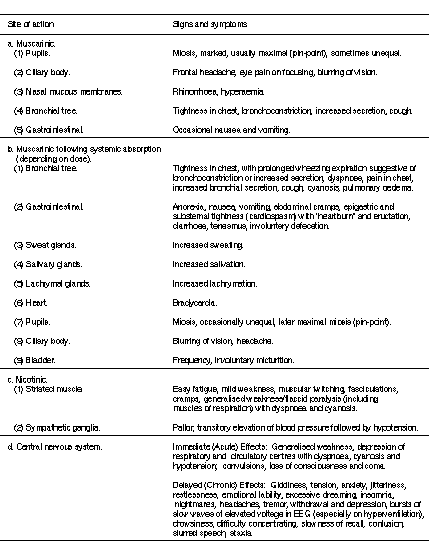a. Poisoning by nerve agents that form rapidly aging complexes (for example Soman) may be particularly difficult to treat. These difficulties have been solved, in part, by the use of carbamates as pretreatment. The terms pretreatment or prophylaxis should perhaps be defined as used in this context:
1. Pretreatment: the administration of drugs in advance of poisoning designed to increase the efficacy of treatment administered post-poisoning.
2. Prophylaxis: the administration of drugs in advance of the poisoning designed to make post-poisoning therapy unnecessary.
b. The terms are to an extent interchangeable and as, in cases of severe poisoning, post-poisoning therapy is nearly always needed, the term pretreatment will be used here.
c. Carbamate anticholinesterases, e.g., pyridostigmine, may be used as pretreatments against nerve agent poisoning by virtue of their capacity to bind acetylcholinesterase reversibly, preventing the organophosphate (OP) binding to the enzyme. The term reversible is here used comparatively: the carbamate-acetylcholinesterase complex breaks down fairly rapidly, while organophosphate-acetylcholinesterase complexes break down very slowly. The aged soman-acetylcholinesterase complex breaks down virtually not at all.
d. When carbamates are used as pretreatments, carbamoylation of acetylcholinesterase prevents phosphorylation, but later the carbamate-acetylcholinesterase complex dissociates, freeing active enzyme. Current pretreatment regimes bind 30-40% of available red blood cell acetylcholinesterase, thereby allowing the carbamate to protect some of the acetylcholinesterase against attack by nerve agent.
e. The carbamate pyridostigmine, given in a dose of 30 mg every 8 hours, is used as a pretreatment. In conjunction with post exposure therapy, good protection against lethality is obtained within 2 hours of the first dose, but is not optimal until the third dose.
f. Pyridostigmine pretreatment should be stopped upon developing symptoms of nerve agent poisoning following a chemical warfare attack and post exposure therapy started.
g. Pyridostigmine tablets were taken over a 4 to 5 day period by large numbers of troops during the Gulf War of 1991
1. The effects of pyridostigmine were examined in several studies including one uncontrolled study of 42,000 troops when, following the recommended dose regime, under the stress of combat conditions, gastrointestinal intestinal changes including increased flatus, loose stools, abdominal cramps and nausea were noted by approximately half the population. Other reported effects were urinary urgency, headache, rhinorrhoea, diaphoresis and tingling of the extremities. These effects were considered tolerable. They did not noticeably interfere with performance of the full range of demanding physical and mental tasks required of service personnel.
2. Symptoms due to pyridostigmine may be ameliorated by taking the tablets with food.
3. Pyridostigmine pretreatment was discontinued on medical advice in less than 0.1% of individuals, generally because of intolerable nausea and diarrhoea.
h. When taken in excess of the recommended dosage, symptoms of carbamate poisoning will occur. These include diarrhea, gastrointestinal cramps, tight chest, nausea, rhinorrhoea, headache and miosis.
i. Good compliance is required if optimal protection is to be obtained. The importance of pyridostigmine pretreatment should therefore be stressed during training.

